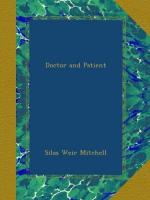As I look from my window, on the lawn below are girls at play,—gay, vigorous, wholesome; they laugh, they run, and are never weary. How far from them and their abounding health seem the possibilities of such torment as nature somewhere in life reserves for most of us. As women, their lives are likely, nay, certain, to bring them a variety of physical discomforts, and perhaps pain in its gravest forms. For man, pain is accidental, and depends much on the chances of life. Certainly, many men go through existence here with but little pain. With women it is incidental, and a far more probable possibility. The most healthy will have least of it. Vigor of body is its foe. Thin blood is its ally. Speaking now, not of the physiological pain, which few escape, but of the torments of neuralgia and the like, Romberg says, “Pain is the prayer of the nerves for healthy blood.” As the woman is normally less full-blooded than the man, she is relatively in more danger of becoming thin-blooded than he.
Moreover, the disturbances which come from the nature of her physiological processes subject her to larger risks of lessened blood than man, and hence, for all reasons, she is more likely than he to become anaemic, and out of this to evolve pain in some shape.
If we see that our girls are not overtasked at the age of sexual evolution, that the brain is not overtrained at bitter cost of other developments as essential, we escape a part of this peril. To discuss the question here is not my intention. To secure in our artificial life what is desirable is difficult. It involves matters of dress, exercise, proportion of lessons, diet, and other matters, of which I shall yet say something, and as to which I have elsewhere said a good deal.
But no matter how careful we may be, how thoughtful as to the true needs of these young lives, we may be sure that our daughters will be more likely to have to face at some time the grim question of pain than the lads who grow up beside them.
For both there are always the little ailments of childhood,—the hurts, the accidents, and the disorders or the diseases of youthful years. All come in for a share. Let us be careful how we deal with them. I have often watched with interest a mother beside the girl or boy in temporary pain. As a rule, she assumes from the beginning that the hurt boy is to be taught silent, patient endurance. What! you, a boy, to cry! Be a man! Among his comrades he is a “cry-baby” if he whimpers, “a regular girl,” “a girl-boy.” He is taught early that from him endurance is expected; the self-conquest of restrained emotion is his constant lesson.
If it be a girl who suffers, she is assumed to be weak, and it is felt that for her tears are natural and not to be sternly repressed; nor are her little aches and complaints dismissed as lightly as are her brother’s. She is trained to expect sympathy, and learns that to weep is her prerogative. The first gush of tears after a hurt of body or mind is in some mysterious way a relief, and not rudely to be chidden; but, on the whole, it is wise and right to teach patience and unemotional endurance to the sex which in life is sure to have the larger share of suffering. To be of use, this education must begin reasonably early, and we may leave to the mother to make sure that it is not too severe.




